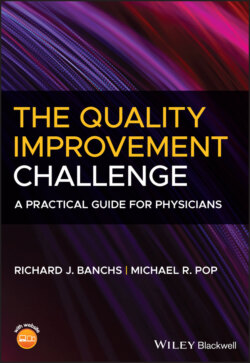Читать книгу The Quality Improvement Challenge - Richard J. Banchs - Страница 81
Example: Patient Satisfaction with UI Health Outpatient Care Center
ОглавлениеIf our QI project aimed to improve patient satisfaction with UI Health Outpatient Care Center, we would first need to define what are the attributes and requirements of a visit to the Center that deliver the experience the patient expects. The first step would be to get the Voice of the Customer. Remember, these statements are usually too broad and lack specificity to be used as guidance in our improvement efforts. Once we got the VOC, we would develop the CTQs, or specifications that are going to make our patients’ statements meaningful, specific, and more importantly, measurable. To do this, we would group the VOC statements with similar meaning into families and then ask ourselves, “What do these statements have in common?” We would then summarize each group or family of statements into single‐word descriptors or “drivers” of patient satisfaction. We may need to dig deeper within the VOC statements to find specifics, or go back to patients to ask questions about the drivers. This would allow us to create one or more CTQ for each driver. The CTQs are the specifications for the attributes and requirements of the outcome the patient expects. In the UIH clinic example, CTQs would be: “greeted with a smile”; “registered within 5 minutes”; “accurate information”; “seen by provider within 30 minutes of my arrival”; and “availability of guest features.” The great thing about a CTQ is that it can be measured to establish our current performance, and audited to assess the degree to which we are continuing to achieve patient satisfaction (see Figure 8‐4).
FIGURE 8‐4 The attributes and requirements for patient satisfaction (CTQs) at UI Health Outpatient Care Center.
